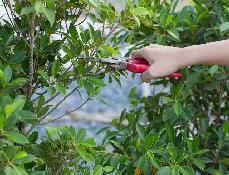
5 minute read
InYourGarden
Monthly gardening ideas & tasks by Andrew Staib of Glorious Gardens
West Dean - Creative Spaces Like all Head Gardeners, Tom Brown can’t speak without stooping to pull out the odd weed as we make our way around West Dean Gardens. With 100 acres of garden including an Arboretum, College grounds, 13 Victorian greenhouses, orchards, walled gardens and plenty of other interesting spaces, he has a lot to do in a day. Made into an educational trust by Edward James in 1964, the college, which is situated in the heart of the gardens, fulfilled Edward's desire to nurture music, traditional crafts and the fine arts, which he feared would go into decline after the Second World War. James was a poet and artist, responsible for commissioning many works, including the surrealist furniture, Mae West Lips Sofa and Lobster Telephone by Dali. In the three years since he arrived, Tom has been inspired by the history and purpose of the college, beginning an ambitious programme of transformation. “Even though Covid was a difficult time, with only myself and one other maintaining the whole gardens, it was a liberating moment. We had to run the garden in a very different way and take stock of our priorities. Since my appointment, there was an ambition amongst the Trustees to align ourselves with the the dynamics of the Art College, rather than concentrate on Victorian style horticulture. When the box blight took out the ornamental shrubs, we decided to move away from a dependency on a few species and develop new plant communities.” We discuss the new Spring Garden. “We’ve put in 30-40 types of dogwood there, and rather than go for the normal combination of Birch and Hellebores, we’ve decided to experiment with
Advertisement
Photinia Tom Brown West Dean's Head Gardener Eucalyptus and Cherries. We’ve also tried to merge the garden with the surrounding landscape by making the gardens more wild as they move away from the college. Tom Brown leads me on. Like most gardeners he is flat out in May but he talks of a different tiredness. “I’m shattered working here, but it is an enjoyable fatigue as we push ourselves- we drink lots of coffee!” We drive down to the Dry Meadow. In a bold move which Tom admits was scary, he and his team imported 120 tonnes of recycled concrete chips from Chichester Recycling Centre. “By placing the new chips thickly over the ground, and then planting amongst them, we are hoping the shingle will heat up, drying quickly on the surface, and prevent weeds growing. It’s an experiment that the public seem to support once we explain our rationale. We are using Dianthus, Linaria Pupurea, Eryngiums and other deep rooted, drought resistant plants.” Another example of Tom’s creative approach is the kitchen garden. “We used to be a kitchen garden based on display - Look how big our prized cabbage is! - but we are looking to be more sustainable. I discuss with the chefs in
the restaurant the three main veg I am growing in any given month and they have to come up with a menu that utilises the seasonal ingredients. In the past the chefs would have wanted the same ingredients all year round. So during the winter we are providing stored squash, over winter beetroot and dried borlotti beans." “I see West Dean garden as educational, not just an ornamental garden or a farm." As we walk through the meticulously maintained walled garden he explains the running of the garden, West Dean gardens with 5 full time gardeners, 2 trainees and 50 volunteers. “Every morning 4/5 volun- down to the stables to make a trapdoor for the teers come in and give us a level of vital detail Bantam chickens!” which we wouldn’t be able to have otherwise.” We make our way through the glasshouses; Tom pauses and laments that there is little beautiful delicate Victorian buildings still with money in gardening, and that he knows garden- their cast iron, patterned flooring that allows ers that have to supplement their income with them to be heated from below. Tom is articulate other jobs. “There are very few gardens that with having to justify new ideas to the Board of turn a profit but I am happy in my job. I have a Trustees. He summarises his approach. “We are lot of creative opportunities. I installed a four a very big space and this requires brave, big metre dragon kite in the oriental vegetable bed, planting. I also want to hand over a well manand recently some furniture students came aged, labelled collection when I eventually



move on. We don’t use peat or sprays. We want this to be a creative space, working in tandem with the ethos of the college. He turns to the Tropical Garden, full of shaggy banana trees bursting with new growth, with a deep path running through the mini hills covered in bark chip. “ We want to create an immersive experience” What to do in July The National Garden Scheme is still running - best to check locally if you have to book first. Founded in 1927 the scheme encouraged people to open up their gardens to the public to raise money for the newly formed district nurses role in poor urban areas. It has moved on since then, from “a shilling a head” to raised over 20 million pounds for a variety of charities in the last 10 years. If you go to the NGS website and type in ‘Sussex’ the dates you are free and you will find 36 gardens that are opening their gates in July though each garden is just open for a day or two only. Most serve tea and cakes though with Covid this may not be the case. www.ngs.org.uk

July tasks
• Deadhead perennial flowers - they will often create a new flush of buds as you inhibit the energy of the plant going into seed production. Plus the first flush of Hybrid and Patio roses may have finished so deadhead them back to a couple of new, outward facing buds. • Bring out any tender plants from your conservatory and let me get a good dose of sun. • Clear blanket week from ponds • Cut back any shrubs that flowered in June eg
Wigelia, Choysia and
Philadelphius • Water well! Any new plants that went in this year will dry out much faster than established plants as their roots are not as plugged into the surrounding soil. • Keep pinching out side shoots on your tomatoes • Keep sowing salad for a continuous crop











